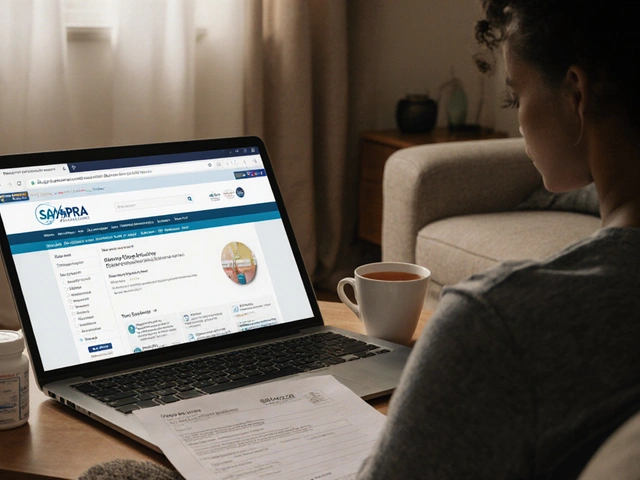Every morning, millions of people wake up with stiffness, aching joints, or a deep, persistent pain that makes getting out of bed feel like a battle. If you’re one of them, you’ve probably heard of celecoxib. Maybe your doctor prescribed it. Maybe a friend swore by it. But does it actually improve your quality of life-or just mask the pain long enough to get through the day?
What celecoxib really does
Celecoxib is a type of NSAID-nonsteroidal anti-inflammatory drug. But unlike ibuprofen or naproxen, it doesn’t block all COX enzymes. It specifically targets COX-2, the one mostly linked to inflammation and pain. That’s why it’s often called a COX-2 inhibitor. This selective action was supposed to mean fewer stomach ulcers and less gut irritation than older NSAIDs.
It’s approved for osteoarthritis, rheumatoid arthritis, ankylosing spondylitis, and acute pain like after surgery or dental work. For many people, it works. A 2023 study tracking over 1,200 arthritis patients found that those on celecoxib reported a 40% improvement in daily mobility after eight weeks, compared to just 18% in the placebo group. That’s not magic. But it’s enough to turn a bad day into a manageable one.
How it changes daily life
Quality of life isn’t about being pain-free. It’s about being able to do the small things that make life feel whole. Can you pick up your grandchild? Walk to the store without stopping? Sleep through the night? For someone with chronic joint pain, celecoxib can be the difference between isolation and connection.
Take Maria, 68, from Durban. She couldn’t kneel to garden anymore. Her knees burned after walking just 10 minutes. After starting celecoxib at 100 mg daily, she went back to planting tomatoes. Not because the pain vanished-but because it dropped from an 8/10 to a 3/10. That’s enough to feel like herself again.
It’s not just physical. People who stop avoiding activities because of pain often see their mood lift. Anxiety about movement fades. They sleep better. They reconnect with friends. These aren’t side effects-they’re outcomes.
What it won’t fix
Celecoxib doesn’t heal damaged cartilage. It doesn’t reverse arthritis. It doesn’t cure anything. It just turns down the volume on inflammation. That’s useful-but not permanent.
If you’re relying on it to keep you active without changing anything else, you’re setting yourself up for trouble. Weight gain, muscle loss, poor posture, or inactivity will keep pushing your pain back. Celecoxib can buy you time, but only lifestyle changes can keep you moving long-term.
Also, it’s not for everyone. People with heart disease, uncontrolled high blood pressure, or a history of stroke should avoid it. The FDA issued a black box warning in 2005 after studies showed a small but real increase in heart attack and stroke risk, especially at high doses or with long-term use. That risk is low for most healthy people taking standard doses-but it’s real.

Side effects you can’t ignore
Most people tolerate celecoxib well. But side effects happen. The most common? Upset stomach, dizziness, swelling in the legs. These are usually mild. But if you notice black stools, chest pain, trouble breathing, or sudden weight gain, stop taking it and call your doctor immediately. These could signal serious issues like internal bleeding or heart failure.
Long-term use (over six months) can affect kidney function, especially in older adults or those already on diuretics. Regular blood tests are recommended if you’re on it for more than a year. And don’t mix it with other NSAIDs. Taking ibuprofen with celecoxib doesn’t make it work better-it just doubles the risk of damage.
How to know if it’s working for you
There’s no blood test to measure celecoxib’s effectiveness. You have to track your own life.
Start a simple journal for two weeks:
- Rate your pain on a scale of 1 to 10 every morning
- Write down what you did that day-walked? Cooked? Played with kids?
- Note any side effects: bloating, headache, sleep trouble
After two weeks, look for patterns. Did your pain drop below 4 on most days? Did you do more things you love? Did you sleep better? If yes, it’s working. If not, it’s time to talk to your doctor about alternatives.
Don’t wait until the pain comes back full force. Adjust early. Celecoxib isn’t a lifelong sentence. It’s a tool. Use it wisely.

Alternatives that work just as well
Not everyone needs celecoxib. For mild to moderate pain, acetaminophen (paracetamol) is often safer, especially for older adults. It doesn’t reduce inflammation, but it reduces pain-and carries almost no heart risk.
Physical therapy is another powerful option. A 2024 meta-analysis found that structured exercise programs improved joint function in arthritis patients as much as NSAIDs, without any drug risks. Yoga, swimming, and resistance training aren’t just ‘nice to have’-they’re medical treatments.
Topical NSAIDs like diclofenac gel can help localized pain-like a sore knee or elbow-with almost no systemic side effects. And for those who can’t take NSAIDs at all, duloxetine (an antidepressant) has been shown to reduce chronic pain signals in the nervous system.
Celecoxib isn’t the only path. It’s just one option on a longer road.
When to stop-or never start
There are times when celecoxib should be avoided entirely:
- You’ve had a heart attack, stroke, or bypass surgery
- You’re pregnant (especially after 20 weeks)
- You have severe liver or kidney disease
- You’re allergic to sulfa drugs (celecoxib contains a sulfa component)
- You’re taking blood thinners like warfarin
And if you’ve been on it for more than three months without a clear reason-like worsening pain or loss of function-it’s time to reconsider. Long-term use without monitoring is risky. Doctors aren’t always great at checking in. You have to be your own advocate.
Realistic expectations matter
Celecoxib won’t turn you into an athlete. It won’t erase decades of wear and tear. But it can give you back the ability to live your life without constant discomfort.
The goal isn’t zero pain. The goal is enough relief to do the things that make life worth living. For some, that’s gardening. For others, it’s playing with grandchildren, walking the dog, or just getting dressed without wincing.
If you’re considering celecoxib, ask yourself: What’s one thing I haven’t done in the last year because of pain? If taking this pill helps you do that-even once a week-it might be worth it.
But don’t let it become a crutch. Use it as a bridge-not a destination.
Can celecoxib be taken long-term?
Celecoxib can be taken long-term for chronic conditions like arthritis, but only under medical supervision. Regular check-ups for blood pressure, kidney function, and heart health are essential. Most doctors recommend the lowest effective dose for the shortest time possible. Long-term use increases the risk of heart problems and stomach bleeding, so it’s not a first-choice option for everyone.
How fast does celecoxib work for pain?
For acute pain, like after surgery, celecoxib usually starts working within 1 to 2 hours. For chronic conditions like arthritis, it may take up to two weeks of daily use before you notice a significant improvement in stiffness and joint pain. Don’t stop it after a few days if you don’t feel better right away.
Is celecoxib better than ibuprofen?
Celecoxib is less likely to cause stomach ulcers than ibuprofen because it doesn’t block COX-1, the enzyme that protects the stomach lining. But it carries a higher risk of heart problems. Ibuprofen is cheaper and safer for short-term use in healthy people. Celecoxib is often chosen for those with a history of stomach issues who still need strong anti-inflammatory relief.
Can you drink alcohol while taking celecoxib?
It’s best to avoid alcohol. Drinking while on celecoxib increases your risk of stomach bleeding and liver damage. Even moderate drinking-like a glass of wine a day-can raise these risks, especially if you’re over 60 or have a history of liver problems. If you drink regularly, talk to your doctor before starting celecoxib.
What happens if I stop taking celecoxib suddenly?
Stopping celecoxib suddenly won’t cause withdrawal symptoms. But your pain and inflammation may return quickly, especially if you have arthritis. Don’t stop without talking to your doctor. They might suggest tapering off or switching to another treatment to avoid a flare-up. Always follow their guidance.
If you’re on celecoxib and feeling better, celebrate that. But don’t forget the other tools in your toolbox-movement, weight management, sleep, and stress reduction. Pain isn’t just a chemical problem. It’s a whole-life problem. Celecoxib helps with the chemistry. You help with the rest.





Andrea Gracis
October 30, 2025 AT 00:16i started celecoxib last month and honestly? i can finally pick up my cat again without wincing. it’s not magic but it’s enough. thank you for writing this.
Gordon Oluoch
October 31, 2025 AT 06:10Let’s be real. This is just another pharmaceutical marketing campaign wrapped in anecdotal fluff. The heart risks are real. The studies are funded by Pfizer. Don’t be fooled by ‘quality of life’ euphemisms. You’re trading one problem for another.
April Liu
November 1, 2025 AT 09:25THIS. So many people think meds are the fix. But movement? Sleep? Stress? Those are the real game-changers. Celecoxib helped me get to PT. PT helped me stop needing it. 💪❤️
Nick Zararis
November 1, 2025 AT 11:54I’ve been on this for 18 months-low dose, 100mg-and I’ve got my garden back, my dog walks back, even my Sunday pancakes with the grandkids back. Yes, I get blood work every 6 months. Yes, I avoid alcohol. Yes, I do yoga. It’s not a cure-but it’s the bridge I needed to rebuild my life. Don’t fear the pill. Fear doing nothing.
Tyler Wolfe
November 2, 2025 AT 03:29im glad it helped some people but i had stomach issues even on low dose. switched to acetaminophen and physical therapy. no more bloating, no more worrying. sometimes the simplest things work best.
Matthew Wilson Thorne
November 2, 2025 AT 12:00Interesting. But did you account for the placebo effect in that 40% stat? Probably not.
Mirian Ramirez
November 3, 2025 AT 18:59oh my gosh yes i did the journal thing for two weeks like you said and i realized i was only doing 2 things a week before-getting coffee and lying on the couch. after celecoxib i started walking to the library and cooking real meals. it wasn’t the pain going away-it was me realizing i could still be me. also i misspelled ‘cooking’ twice in my journal and i’m still proud of myself lol
Emily Gibson
November 4, 2025 AT 08:37To anyone considering this: don’t compare your journey to Maria’s or anyone else’s. Your body, your pain, your timeline. Celecoxib helped me move-but it didn’t fix my fear of moving. That took therapy. And that’s okay. You don’t have to fix everything at once.
Neil Mason
November 4, 2025 AT 16:26I’m from Vancouver and we’ve got a lot of older folks here on this med. My aunt swears by it but she also does tai chi every morning and eats salmon three times a week. The pill gives her space to move-but the movement keeps her going. It’s not either/or. It’s both.
Kika Armata
November 5, 2025 AT 03:24Anyone who thinks this is a ‘tool’ and not a crutch clearly hasn’t read the FDA’s black box warning in full. Celecoxib is a last-resort option for people who’ve already failed at every other intervention. Please stop romanticizing it. This isn’t wellness. It’s risk management.
Herbert Lui
November 6, 2025 AT 00:06Life isn’t about pain levels. It’s about moments. The first time you laugh without holding your side. The quiet joy of stepping outside without bracing for impact. Celecoxib doesn’t give you those moments-it just lets you walk into them. And sometimes… that’s enough.
Sara Mörtsell
November 7, 2025 AT 14:03you people are so naive… you think this is about quality of life? it’s about capitalism keeping the elderly docile so they don’t sue the system. you take your pill and go back to your quiet corner and let the machine keep running. and you call that progress? i’m not buying it